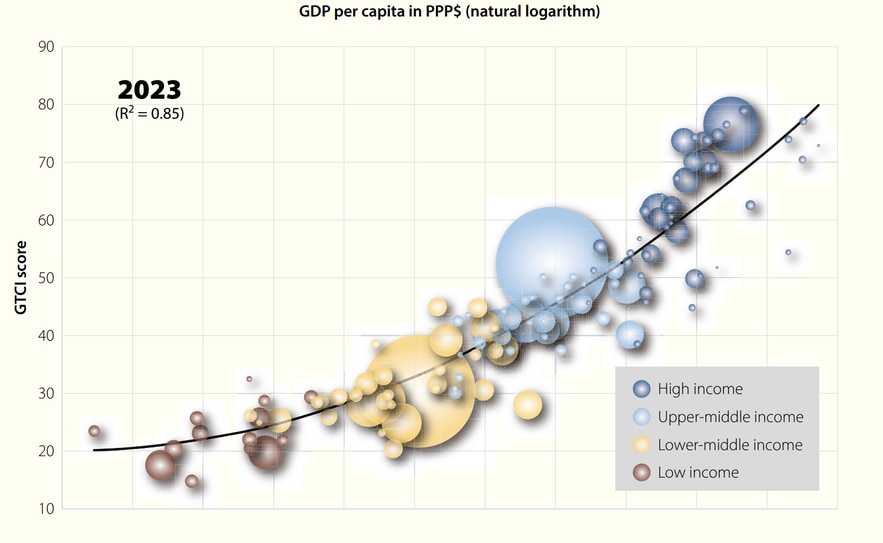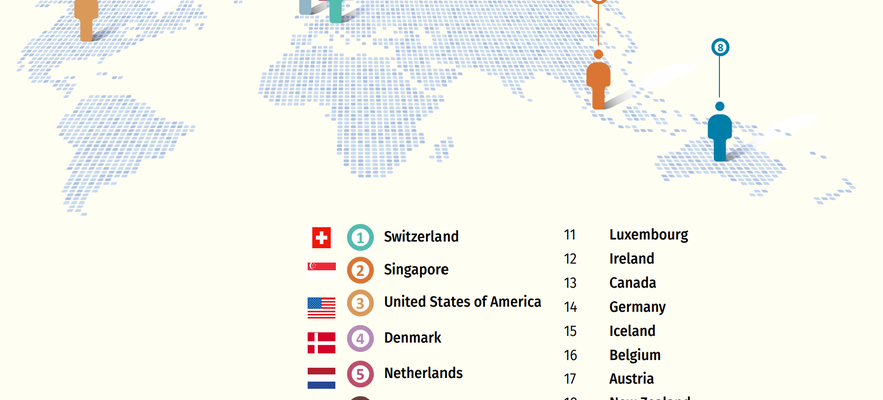Competition is tough for young talents. This Tuesday, November 7, the European Institute of Business Administration (INSEAD) publishes the tenth edition of its Global Talent Competitiveness Index (GTCI). A ranking of the most attractive countries for young workers with sought-after skills, published each year by this French private management school.
A 2023 update again over-represented by European states, highlighting an increasingly significant gap in attractiveness between rich and poor countries.
A ranking dominated by small, rich European countries
In the ranking of the 134 countries taken into account for the year 2023, the podium changes relatively little compared to last year. Unsurprisingly, Switzerland retains its title of country considered the most attractive for young talents. A first place that it has held since the first INSEAD ranking, ten years ago. The report justifies this choice by Switzerland’s very good capacity to create and retain its young talents, as well as by “the strong relevance of its education system in relation to its economy”. The country also knows how to attract young foreign talents, in particular thanks to the quality of its social protection and its environment.
2023 ranking of the most attractive countries, according to the GTCI index.
© / Insead, Descartes Institute, Human Capital Leadership Institute
Just behind, Singapore also remains on the podium. Apart from a fall to third place in 2020, the city-state has always been second in the ranking for ten years. Finally, the United States completes the podium, reversing its position with Denmark, relegated to fourth place.
Overall, the 2023 ranking of this attractiveness index is over-represented by European countries. Among the ten most attractive countries for young talents, we also include the Netherlands, Finland, Norway, Sweden and the United Kingdom. Only Australia (9th) qualifies this observation. France is nevertheless 19th, the same position it has occupied for two years. This is despite improvements in its production of talented young assets, according to the report.
One possible explanation comes from the strengthening of the role of medium-sized and developed cities in the attractiveness of each country. INSEAD indicates in particular that these “second-tier” cities, smaller than megacities, have more and more legal responsibilities and tend to implement more dynamic attractiveness policies. This is particularly the case for the Swiss cities of Lausanne, Zurich and Geneva, the American cities of Boston and Seattle, and the German city of Munich.
Salary, the sinews of the war of attractiveness
Despite everything, the ranking of the most attractive countries remains mainly represented by rich countries. The INSEAD report also highlights the correlation between a country’s GDP per capita and its attractiveness score, and has been doing so for ten years.

Link between a country’s income and the GTCI attractiveness score.
© / Insead, Descartes Institute, Human Capital Leadership Institute
Thus, INSEAD explains this phenomenon by the lack of “resources necessary to attract, develop and retain talent”. In particular, the ability of developing countries to offer high salaries. An infographic included in the report illustrates in particular the link between this attractiveness of talents and the level of income offered to them: the higher it is in a country, the more it attracts young talents.
A gap between rich and poor countries which has been worsening for ten years, according to INSEAD. Despite everything, the attractiveness index notes a significant rise in the ranking of certain emerging economies, notably citing the United Arab Emirates (22nd), as well as China (40th) and Indonesia (80th).
On the other hand, some negative factors persist in developing countries. The report once again highlights this year the weight of gender inequalities in the decline in competitiveness and attractiveness. Here again, this is observed at the level of income: women “continue to be faced with lower salaries and reduced opportunities for career development, even with equivalent qualifications”. Inequalities are even more present in poor or developing countries, due to limited access to education, estimates the report.
Choices influenced by the political and social environment
Although salary seems the most significant factor in the attractiveness of a country, according to this index, the report also highlights generational effects. Like many others, more and more young workers with sought-after skills are more attracted to “work that is meaningful, that contributes to society or the environment,” says INSEAD.
These generational factors would thus weigh more and more in the balance, pushing this generation of young talents to desire a better balance between their professional and personal lives. This is defined in particular by the living environment offered by each country. The 2023 attractiveness index thus indicates that young talents are increasingly taking this quality of life into account, particularly since the Covid-19 pandemic: teleworking has made these young professionals more flexible about where they live.
Beyond that, the INSEAD report notes that talented young workers are generally more influenced by the current political and geopolitical context. Since 2020, the “decrease in international cooperation due to the resurgence of nationalism and protectionism” is said to dampen the abilities and interest of young skilled workers to settle in a different country. A withdrawal into oneself which therefore risks widening the gaps a little further between the countries in the ranking.
